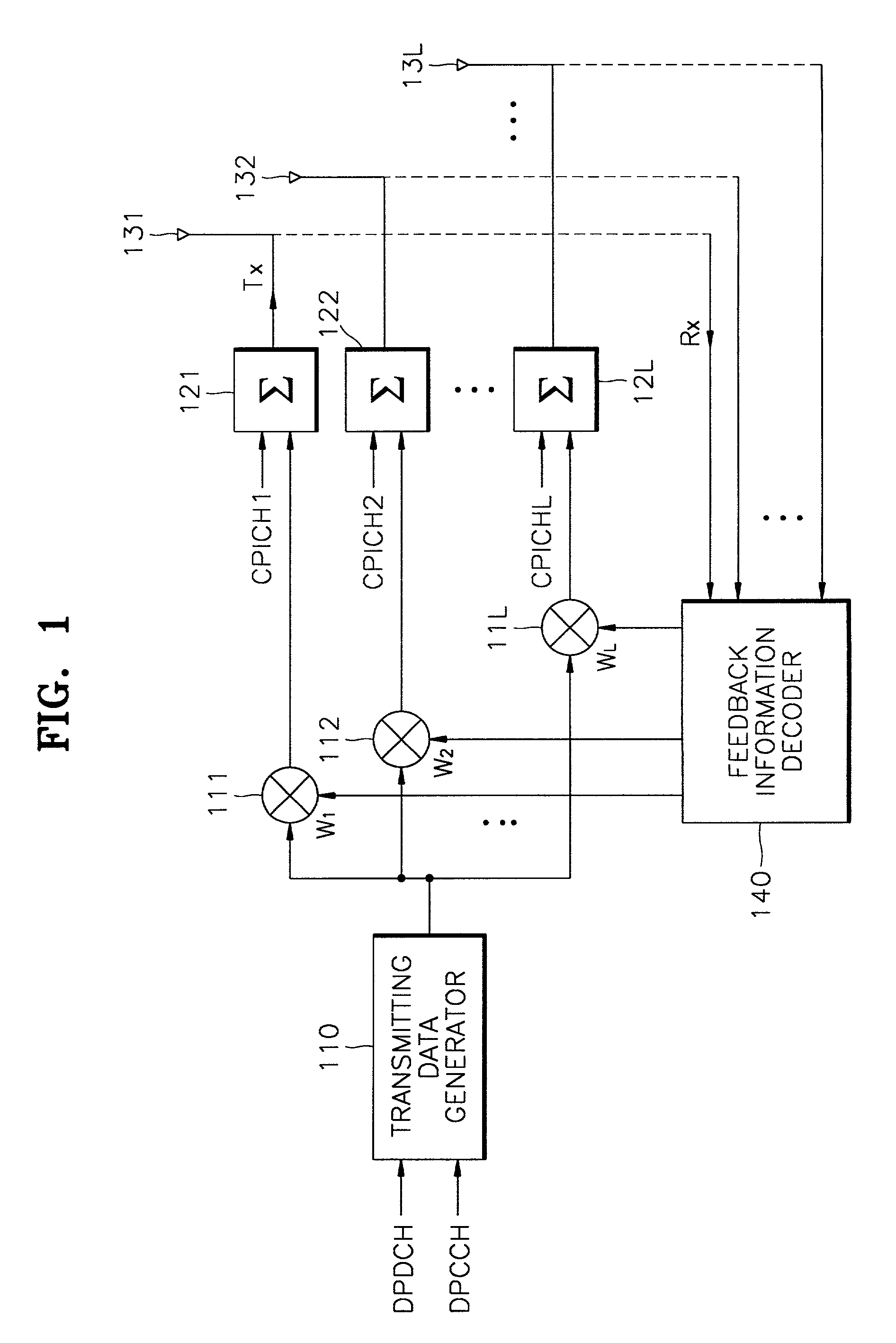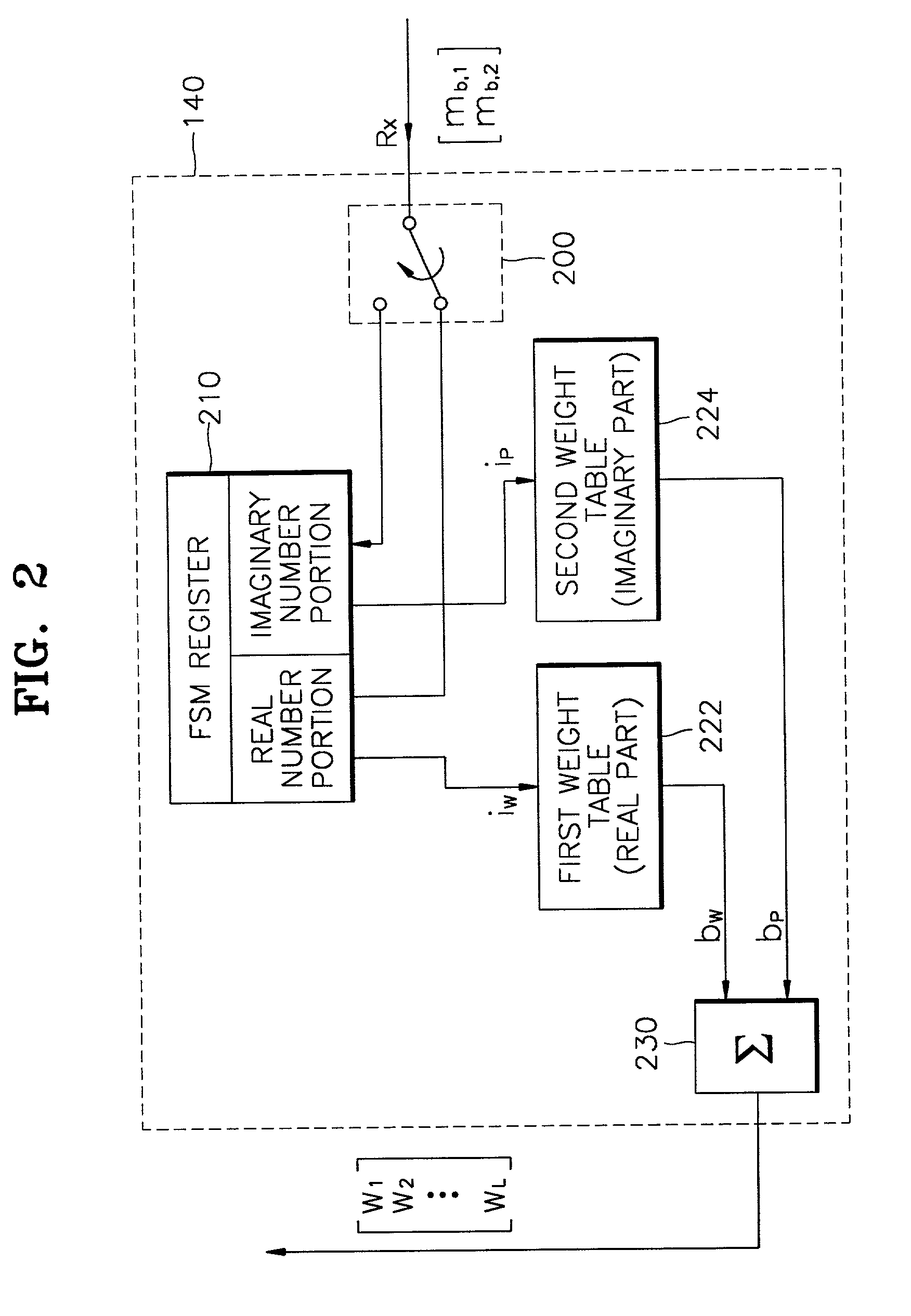Closed loop transmit diversity method and apparatus using complex basis vector sets for antenna selection
a technology of complex basis vectors and closed loops, applied in the field of transmission antenna diversity, can solve the problems of difficult to use this method in a low-speed doppler channel, difficult to install reception antenna diversity in a mobile, and poor operation of reception diversity
- Summary
- Abstract
- Description
- Claims
- Application Information
AI Technical Summary
Benefits of technology
Problems solved by technology
Method used
Image
Examples
first embodiment
[0051]In a first embodiment, a basis vector with respect to which maximum power is received is obtained using an orthonormal basis vector set, and an index corresponding to the basis vector is fed back.
[0052]1) A channel information matrix HBW obtained by transforming a receiving channel information matrix H using a transform matrix Bw composed of an orthonormal basis vector set is calculated as follows.
HBW=HBw
[0053]Here, H=[h1 h2 h3 h4], Bw=[bw(0) bw(1) bw(2) bw(3], h1 is a column vector composed of multi-path channels transmitted from a first antenna, and bw(i) is a basis vector corresponding to an i-th index in the basis vector set. In the case of a binary system, the amount of calculation can be reduced by using a Hadamard matrix transform. In the other cases, the performance can be increased by using a high-speed algorithm suitable for the characteristics of each transform matrix.
[0054]2) A norm of each column vector constituting the channel information matrix HBW is obtained. ...
second embodiment
[0057]In a second embodiment, S vectors among M orthonormal basis vectors are used.
[0058]1) For example, 4 orthonormal basis vectors exist with respect to 4 antennas. Accordingly, S is one of 1 to 4. The values of M and S are stored.
[0059]2) Antenna selection weights wb,i are prepared from the result of step 1. The antenna selection weights wb,i can be obtained by transforming antenna weights wi used in a base station having a transform matrix Bw according to the equation wb,i=Bwwi. The antenna selection weights wb,i for antennas other than a selected antenna are 0.
[0060]3) A measured reception power Pi=wb,iHHBWHHBWwb,i is calculated using the antenna selection weight wb,i and a channel information matrix HBW. Here, the channel information matrix HBW is obtained by transforming a receiving channel information matrix H using a transform matrix Bw composed of an orthonormal basis vector set.
[0061]4) Steps 2) and 3) are repeated for MCS cases, which is the number of cases in which S ve...
third embodiment
[0065]In a third embodiment, a complex basis vector set is used, and the amount of feedback information is minimized. Here, a case of using four transmitting antennas will be explained as an example.
[0066]1) A channel information matrix HBW obtained by transforming a receiving channel information matrix H using a transform matrix Bw composed of a Walsh basis vector set is calculated according to HBW=HBw. A channel information matrix HBP obtained by transforming the receiving channel information matrix H using a transform matrix Bp composed of a polar basis vector set is calculated according to HBP=HBP. Here, H=[h1 h2 h3 h4], Bw=[b2(0) bw(1) bw(2) bw(3)], Bp=[bp(0) bp(1) bp(2) bp(3)], h1 is a column vector composed of multi-path channels transmitted from a first antenna, bw(i) is a basis vector corresponding to an i-th index in the Walsh basis vector set, and bp(i) is a basis vector corresponding to an i-th index in the polar basis vector set.
[0067]2) It is assumed that Hew(i) indica...
PUM
 Login to View More
Login to View More Abstract
Description
Claims
Application Information
 Login to View More
Login to View More - R&D
- Intellectual Property
- Life Sciences
- Materials
- Tech Scout
- Unparalleled Data Quality
- Higher Quality Content
- 60% Fewer Hallucinations
Browse by: Latest US Patents, China's latest patents, Technical Efficacy Thesaurus, Application Domain, Technology Topic, Popular Technical Reports.
© 2025 PatSnap. All rights reserved.Legal|Privacy policy|Modern Slavery Act Transparency Statement|Sitemap|About US| Contact US: help@patsnap.com



